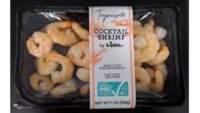On May 22, 2013, the Food Safety and Inspection Service (FSIS) and the Food and Drug Administration (FDA) held a joint public meeting to provide their background, approach, scope and findings used in the draft “Interagency Risk Assessment — L. monocytogenes (Lm) in Retail Delicatessens” that was released on May 13.
Copies of the draft quantitative risk assessment (QRA), Interpretive Summary and related documents may be viewed on the FSIS Web site. Comments on the QRA and related documents are due by July 12.
The QRA was developed to evaluate how conditions in delis affected Lm contamination of ready-to-eat (RTE) cheese, meats and salads. Earlier surveys of Lm in foods purchased at retail delis showed an increase in the level of Lm compared to the same products when tested in the original manufacturer packaging. The QRA was developed to provide a tool to predict the Lm contamination level (and attendant listeriosis risk) from various activities performed in a retail deli operation.
The QRA sets up a “virtual deli,” able to calculate the prevalence and concentration of Lm that would be in the products sold to customers based on various deli activities. The model also can predict changes in concentrations of these values during consumer storage. From this modeling, the QRA estimates the risk of listeriosis once the products are finally consumed. Moreover, the QRA can factor whether the consumer(s) have an increased susceptibility.
Overall, results indicated that delis without niches, that maintained temperature control, provided products with a lower risk, while delis having niches or receiving highly contaminated incoming products supporting Lm growth led to consumers receiving products with a higher risk of listeriosis. A key finding emphasized at the public meeting was that the use of growth inhibitors in products lead to a dramatic reduction in the predicted risk of listeriosis from products purchased at a retail deli.
Companies producing meat and poultry products for retail delis need to understand the level of risk their product contributes to the deli environment. The QRA clearly showed that increasing the amount of Lm in the incoming RTE product and subsequent cross-contamination from that product directly increased the predicted risk of illness. This was true whether or not that incoming product supported growth — though the risk was even greater when it did.
Reviewing the various scenarios in the QRA and what combinations decrease or increase the predicted risk of listeriosis becomes important as companies consider whether or not to add or remove growth inhibitors in products to provide a “natural” or “clean” label. Understanding the risk will assist a company in ensuring that, if it provides a product into the deli environment without growth inhibitors, it develops and maintains robust preventive-control programs in its RTE environments to prevent Lm contamination. Likewise, any company providing product to a retail deli should also ensure that its Lm monitoring programs are aggressive in continually identifying any potential issues that could lead to an increased level of Lm — and increased risk — on that product.



Report Abusive Comment